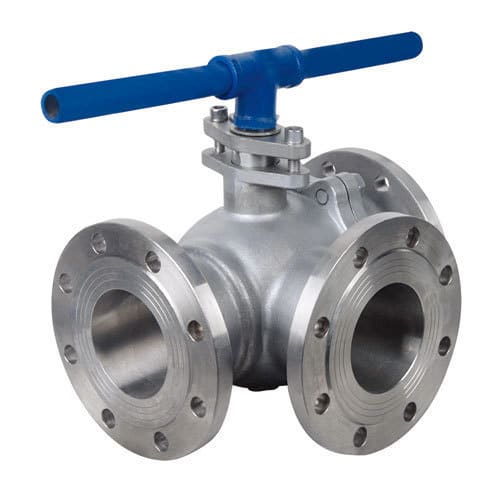A Ball Valve is a quarter-turn valve that controls flow through a hollow, perforated, pivoting Ball. It's open when the hole in the ball valve is parallel to the flow, and it's closed when the valve handle pivots 90 degrees. When the valve is open, the handle is flat against the flow, and when it is closed, it is perpendicular, allowing for easy visual confirmation of the valve's status. KHD Valves Automation Pvt Ltd is a High Quality Three Way Ball Valves in Mumbai, Maharashtra, India.
Three-way ball valves can
- Cut of or shut off flow
- Switch flow between two different sources
- Combine the flow from two different sources
- Alternate flow between two different destinations
- Divert flow coming from one source to another destination
- Split flow coming from one source between two outgoing destinations
Three way Ball valves are one of the most versatile industrial valves in the market. If you want to know more about these valves and how these can help your business, contact KHD Valves Automation for more details. Or you can also get the great manufacturers in this KHD Valves Automation Pvt Ltd
Uses of Three Piece Design Ball Valves
KHD Valves Automation Pvt Ltd's Ball valve's ease of operation, repair, and adaptability lend it to extensive industrial use, withstanding pressures up to 1000 bar and temperatures up to 752 °F (400 °C), depending on design and raw materials used. Sizes typically range from 0.2 to 48 inches (0.5 cm to 121 cm). Valve bodies are made of metal, plastic, or metal with a ceramic; floating balls are often chrome plated for durability. One disadvantage of a Ball valve is that they trap water in the center cavity while in the closed position. In the cold climates, the sides can crack due to the expansion of ice forming. Some means of insulation or heat tape in this situation will usually prevent damage. Another option for this situation is the “freeze tolerant Ball valve”. This style of Ball valve incorporates a freeze plug in the side so in the event of a freeze up, the freeze plug ruptures (acts as a sacrificial disk), thus making for an easy repair. Now instead of replacing the whole valve, just screw in a new freeze plug.
The Construction of 3-Piece Ball Valves
Three-piece ball valves are manufactured with one main body and two pipe connectors. The pipe connectors are typically threaded or welded to a pipe. This enables the main body to be easily removed for cleaning or repairs without having to remove the pipe connectors. Full port and bidirectional shutoff options are also available.
After installing a 3-piece ball valve wear components — such as balls, ball seats and stems — can be replaced quickly and independently. The biggest benefit here is that the valve can remain in service for its intended lifecycle while operators enjoy low long-term maintenance costs.
Advantages of 3-Piece Ball Valves
Since the main body of a 3-piece ball valve can be removed for cleaning and maintenance, it is often the most cost-effective option in the long run. Changing seats and seals is more affordable than replacing the entire valve, and not having to remove the pipe connectors prevents a line shutdown should maintenance be required.
Advantages of three-way ball valve:
- Low fluid resistance
Resistance coefficient is equivalent to the pipes having the same length.
- Simple structure, low volume, light weight.
- Reliable sealing.
The sealing face is made of various materials. The valve has good sealing, being widely utilized in vacuum system.
- Convenient operation
Open or close rapidly. Only turning 90°can open or close valve completely, convenient for remote control
- Convenient maintenance
Ball valve has simple structure. Sealing ring is flexible. Disassembly and replacement are convenient.
- When the valve is opened or closed completely, ball and sealing face of seat are separated from medium.
The sealing face is not eroded by medium when passing through.
- Wide application range.
Diameter ranges from millimeter to meters. The valve can be used under high vacuum or high pressur





